
This article will look at the multi-genre International actor and highlight some specific features he made over his 84 film career between 1950 and 2008. The year of his death.
STARTING OUT
John Phillip Law was born in Los Angeles on September 7, 1937. His father was a Los Angeles County Sheriff named John Law. Which must have presented him with many jokes based upon his name. John Phillip's mother was a actress named Phyliss Sailee. His younger brother was Thomas Augustus Law who had one film credit to his name and this was with his brother John.
That was the 1968 motion picture "Skidoo" Directed by Otto Preminger and starring Jackie Gleason, Carol Channing and Frankie Avalon/ It was a parody of the Hippie Counter Culture of the time. Tom Law was also the road manager for the Folk Singing Group "Peter, Paul and Mary".
Returning to John Phllip. He attended Hollywood High School. The actor's first on screen role was at age 13. This was the non screen credited, non-speaking part of a Supreme Court Page in Director John Sturges' 1950 film "The Magnificent Yankee". He was next an "Extra" in the 1951 MGM musical "Show Boat" Then his name doesn't show up on the motion picture screen until 11 years later. The title of the picture was "SMOG" and was said to be Hungarian, but the Producer, Director and main crew were Italians. As was the majority of the cast with the exception of a few American names including John Phillip Law. This 1962 movie takes place entirely in Los Angeles and that might have been the reason for the title. I could not locate any description of the story.
Part of the period between 1951 and 1962 was spent at the University of Hawaii studying acting and appearing in productions there. Law had moved to New York to study under Director Elia Kazan in the Lincoln Center Repertory Company. Not finding work in films in the United States he moved to Europe and appeared in two Italian feature films. American Director Norman Jewison saw them and cast John Phillip Law in the 1966 comedy "The Russians Are Coming, the Russians Are Coming".
Above, Law is between Carl Reiner and Alan Arkin. Behind them is Eva Marie Saint.
John Phillip Law had ninth billing for this major Hollywood Comedy. He portrayed the Sailor sent ashore by the Captain of the grounded Soviet Submarine and falls in love with a "Capitalist" girl. Looking at the poster you see the cartoon drawing of Law's "Alexei Kolchin" looking love sick at actress Andrea Dromm as 18 year old babysitter "Alison Palmer",
The following year, on February 9, 1967, American audiences saw John Phillip Law with third billing and co-starring with Michael Caine and Jane Fonda in another Otto Preminger motion picture "Hurry Sundown".

.
DEATH RIDES A HORSE
Think of Spaghetti Westerns and the name of Director Sergio Leone immediately comes to mind for most American's. However, as Italians knew, he wasn't the only Director of this genre and Clint Eastwood wasn't the only America to star in some of these features.
Released in Italy on August 31, 1967 was "Da uomo a umom (As man to man)". The feature wouldn't reach the United States until June 25, 1969 as "Death Rides A Horse". It was Directed by Giulio Petroni and starred John Phillip Law and Lee Van Cleef in his third Spaghetti Western.
Think of Spaghetti Westerns and the name of Director Sergio Leone immediately comes to mind for most American's. However, as Italians knew, he wasn't the only Director of this genre and Clint Eastwood wasn't the only America to star in some of these features.
Released in Italy on August 31, 1967 was "Da uomo a umom (As man to man)". The feature wouldn't reach the United States until June 25, 1969 as "Death Rides A Horse". It was Directed by Giulio Petroni and starred John Phillip Law and Lee Van Cleef in his third Spaghetti Western.
The picture is a favorite Spaghetti Western of mine. An outlaw gang arrives at a ranch and kills a boys mother and father. Then some gang rape and kill his sister. The boy was in hiding and one of the gang finds him, but signal's to stay hidden. The boy has been saved by the one outlaw not actually involved in the killing of his family. Luciano Vincenzoni's screenplay gives the audience the outlaws seen from the boys point of view. Each has a distinctive item to identify them by, if ever they meet again and the boy memorizes these. They included a Four Ace Playing Card Tattoo on the chest, an unusual scar, a distinctive earring and the man, below, who saved him, a skull on a necklace.

Switch to 15 years later and "Ryan", Lee Van Cleef, is being released from prison. The gang pulled off a bank robbery after the attack on the ranch and left him to take the blame. Now "Ryan" wants revenge and the money he should have gotten.
The audience sees a young gun man named "Bill Meceita", John Phillip Law, and it is obvious he's the boy whose family was murdered. The two men's path cross and "Ryan" gets the better of the younger inexperienced man. However, they become friends.
The two ride together into a local town and "Ryan" inquires for a man name "Bert Cavanaugh", Anthony Dawson. "Bill" eventually sees the Four Aces Tattoo on "Cavanugh". There will be a duel and "Bill" kills the outlaw.
Afterwards, "Ryan" says he needs these men alive to find out where his money is and he will go his own way.
In Lyndon City both "Ryan" and "Bill" meet again. As "Ryan" is after the rich banker "Walcott", Lugi Pistillim, who was the outlaw leader 15 years ago. "Walcott' frames "Ryan" again for a new robbery of his own bank. "Bill" helps "Ryan" escape the jail and then sets out, alone, to go after another of the murders.
In a small Mexican town "Bill" encounters the man with the earring and guns him down. Members of the original outlaw gang and some others capture and bury him up to his neck. The gang members leave guard to watch "Bill" slowly die and leave to get "Walcott" and the man with the "Scar".
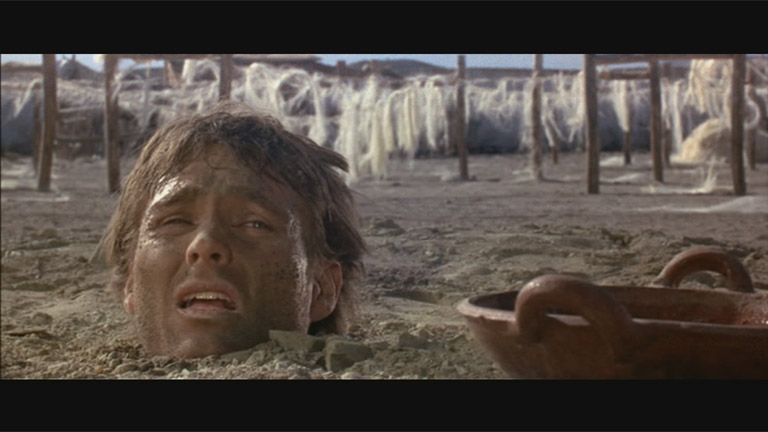
"Ryan", of course shows up and rescues "Bill" and the two prepare to meet the returning outlaw gang and take their separate revenges. However, as the two are working the skull necklace is revealed upon "Ryan", "Bill" reacts, but "Ryan" promises if they are both alive after the others return. He will let "Bill" do whatever he thinks is right towards him.
.
The gang returns and the two meet them during a blinding sandstorm. They're down to the last remaining outlaw who killed "Bill's" family. The man has cornered "Bill" without ammunition, takes aim, as a knife thrown by "Ryan" kills him. Once again saving "Bill's" life.
However, the young man wants his revenge and the two prepare to see whose the fastest on the draw.

At this point "Ryan" turns his back on "Bill" forcing the other to make a decision. "Bill" draws and a shot rings out. One of the thought dead outlaws was still alive. "Ryan" thanks him and watches "Bill" get on his horse and ride away.
For those of my readers, like myself, who are Quentin Tarantino fans. There are many references to "Death Rides A Horse" found in "Kill Bill" Parts One and Two. Along with this features music composed by Ennio Morricone.
It you're also interested in how Europe saw the American West including a Western made by the Soviet Union. My article can be read at:
http://www.bewaretheblog.com/2015/01/american-westerns-european-style.html
The same year as "Death Rides A Horse". John Phillip Law had an non screen credited cameo in another Italian film "L'harem" starring American actress Carroll Baker. The English title of the movie was "Her Harem" and did show up on American television years later.
DIABOLIK
The original Italian comic book series was by Angela and Lucian Giussani and first appeared in 1962. It was about an anti-hero thief turned good guy named "Diabolik" and his girl friend "Eva Kant".

Thief's turned good guys go back decades. Probably the most famous that transitioned from novels, to radio, to motion pictures were "Arsene Lupin" created in 1905 French author Maurice Leblanc amd "Simon Templar aka The Saint" created by British author Leslie Charteris in 1928. Then there was Cary Grant in Alfred Hitchcock's 1955 "To Catch a Thief".
It took six years for a feature film by Producer Dino De Laurentiis to be made. That motion picture would be Directed and co-written by Mario Bava known for his stylistic horror films. Such as 1960's "La maschera del demonio (Mask of Satan)" aka: "Black Sunday", 1963's "l tre volti della paura (The Three Faces of Fear)" aka: "Black Sabbath" and 1965's "Terrore nello Spazio (Terror in Space) aka: "Planet of the Vampires".
My article on Mario Bava and Dario Argento may be found at:
http://www.bewaretheblog.com/2015/07/dario-argento-and-mario-bava-two.html
On Janaury 24, 1968 Italian audiences saw Bava's feature starring John Phillip Law as the title character "Diabolik" and Marisa Mell as his girl friend "Eva Kant". The motion picture wouldn't be released in the United States until May 1968 under the title "Danger: Diabolik".


The "James Bond" spy craze was at it's height in 1968. There were 29 spy films released across the World that year. These included Dean Martin's fourth movie as "Matt Helm" "The Wrecking Crew", "A Dandy in Aspic" starring Lawrence Harvey, "The High Commissioner" starring Rod Taylor and "Hammerhead" starring Vince Edwards. Another Italian spy film was simply called "Italian Secret Service". The amount of product became a problem for De Laurentiis and this picture. Which didn't mean it wasn't good, but it bombed at the Box Office and with Critics. However, the picture has become an International Cult Favorite and especially with fans of Mario Bava.
Below John Phillip Law in "Diabolik" and Marisa Mell in what looks like a scene from any Sean Connery "Bond" film.

The main screenplay writer was Dino Maiuri. He previously had his Italian tongue firmly in cheek with a "Bond" rip off in 1966 for DeLaurentiis. The Italian title was a major hit at 007's image "So tutte le doone del mondo (I Know All the Women in the World)". The English title was "Kiss the Girls and Make Them Die". The movie starred Mike Connors as a CIA agent and Dorothy Provine as an MI-6 Agent.
A second screenplay writer for "Diabolik" was British writer Tudo Gates. In 1970 and 1971 he would turn Sheridan Le Fanu's 1871 Lesbian Vampire story "Carmilla" into a trilogy for Hammer Films starting with "The Vampire Lovers".
The story takes place in the fictitious European country of Clerville. "Police Inspector Ginko", Michel Piccoli, will be transporting $10 million dollars from a bank. His plan is to confuse his nemesis "Diabolik". The Inspector has it appear that an armed truck has the money and along with some of "Ginko's" other police officers. He will have the money in a Rolls Royce. This does not fool "Diabolik". Who steals the money, goes to his underground hideout with his lover, "Eva Kant", and the two make love on top of the cash.
"Ginko" next attempts to stop "Diabolik" by getting permission to use a master criminal named "Ralph Valmont", Adolfo Celi, "Largo" in 1965's "Thunderball". He has been offered a light sentence for his help. This idea involves a famous Emerald necklace as a lure for the thief, but "Diabolik"scales a wall of a castle, steals the necklace, and escapes.

"Valmont" has captured "Eva" and the police are closing in on "Diabolik". The thief makes it to the place "Valmont" is keeping his love and rescues her, but before that. "Diabolik" had taken the necklace apart and loaded all the emeralds into his gun's magazine. In a confrontation he shoots and kills "Valmont". "Eva" leaves and as the police close in "Diabolik"/ He takes a pill that makes it appear the thief is dead.
"Ginko" is holding a press conference about the death of "Diabolik". In the autopsy room as a doctor is about to perform one on "Diabolik". He returns to life and "Eva" dressed as a nurse wheels him right past "Ginko" in the middle of his Press Conference.
Disguised the thief returns to the morgue. "Valmont's" body has been cremated and he removes the Emeralds. "Ginko" realizing that the thief is still alive offers a million dollar reward for his capture. In retaliation, for the reward being posted, the thief blows up the Tax Office for the entire country and all the tax records are destroyed. This forces the country into debt as no one wants to pay more taxes.
The country has twenty tons gold, don;t ask, and this will be used to purchase currency for the country. However, "Ginko" is worried "Diabolik" will attempt to steal it. So all the gold is melted into one solid block and placed into a steel casket. The gold block is being transferred on a guarded train. It reaches a bridge over a river with a burning truck blocking the other side. A bomb explodes and the train falls into the water. "Ginko" makes it to shore as "Diabolik" and "Eva" enter the water and collect the gold.
A GPS style tracker was in the casket and "Inspector Ginko" has the location of "Diabolik's" underground hideout. The police enter to see the thief smelting the gold into smaller ingots. He is wearing a heat proof suit.

During the police raid the thief is unable to control the smelting process and the entire hideout gets covered in exploding gold including "Diabolik". The police decide to seal off the cavern and "Ginko" allows "Eva" to pay her last respects to the dead "Diabolik". As she walks up to him he winks. END.

This film was immediately followed by another Dino De Laurentiis motion picture based upon a comic book. This time not Italian, but French.
BARBARELLA
In 1962 Jean-Claude Forest created a French Science Fiction Comic Book with a very sexy heroine named "Barbarella".
.jpg)

There was no question, at least in France, that "Barbarella" had to come to the big screen. Initially the screenplay was written by Terry Southerland, At the time of this production Southerland had worked on the excellent, find it, "Black Comedy" attack on the funeral business "The Loved One", the Steven McQueen, Edward G. Robinson answer to Paul Newman's "The Hustler" entitled "The Cincinnati Kid" and British Actor Terrence Stamp's chilling performance as "The Collector". All three films in 1965.
When filming began on "Barbarella". Changes to Southerland's screenplay began and the end result was a screenplay by seven writers. Which included the original comic book author and the picture's Director Roger Vadim.
For the title role Italian actress Virna Lisi was first considered. Next Vadim considered French actress Bridgette Bardot and Italian actress Sophia Loren, but in the end went with his third wife American Jane Fonda.
Each of Roger Vadim's first three wives appeared in one of his major motion pictures. His first the aforementioned Bridgette Bardot in 1956's "And God Created Women", his second Annette Stroyberg in Vadim's stylish version of Le Fanu's "Carmilla" 1960's "Blood and Roses" and of course Jane Fonda in this film. My article on these three films and actresses may be read at:
http://www.bewaretheblog.com/2016/08/rodger-vadim-three-wives-and-three.html
The motion picture opens with a space suited Jane Fonda doing a strip tease, to remove it in zero gravity, as the opening credits role. This sets the tone of the picture and its theme song, by the "Wondermints", gives the viewer the period it was really filmed. The movie was released October 11, 1968.
It's a wonder, Wonder woman
You're so wild and wonderful

The basic plot has a weird flying creature drop a Golden Tablet on "Sinbad's" ship. He decides to place it around his neck and that night he dreams of a young women with a tatoo of an eye on her hand.

Also in his dreams "Sinbad" sees a vision of "Prince Koura". Events lead him to the coast town of Marabia. There "Sinbad" meets the "Grand Vizier" who wears a golden mask to cover his scared face.

The "Vizier" explains that what ":Sinbad" has placed around his neck, Is one piece of a puzzle that leads to the "Fountain of Destiny" on the fabled continent of Lemuria. The "Vizier" shows "Sinbad" his own piece of the puzzle and the sailor realizes these are parts of a map.
The flying creature that dropped the piece of the map over "Sinbad's" ship was a homunculous made through dark magic using "Prince Koura's" own blood. This process is also draining "Koura" of his life force. The creature is sent to find out what the "Vizier" and "Sinbad'" plan and report back to "Koura". As he possesses the third piece of the puzzle to complete the map.

"Prince Koura" hires a ship to follow the sailor and his crew. As I said in my view John Phillip Law is the perfect "Sinbad" to counter Tom Baker's "Prince Koura" and interact with bravery against the creations of stop motion artist Ray Harryhausen.
In "The 7th Voyage of Sinbad" Harryhausen's improved stop motion process was called "Dynamation". In his next feature the "3 Worlds of Gulliver" the process became "Superdynamation" and starting with this feature the process was now called "Dynarama". Each version not just a name change, but a major improvement in the stop motion process over the previous one. The last using a vastly superior to British Black Screen as compared to either the typical Blue of the period, or the still be perfected Green Screen.
Among Ray Harryhausen's creations are the figurehead of "Sinbad's" ship that comes to life:

The Hindu goddess and destroyer of evil forces Kali:
Switch to 15 years later and "Ryan", Lee Van Cleef, is being released from prison. The gang pulled off a bank robbery after the attack on the ranch and left him to take the blame. Now "Ryan" wants revenge and the money he should have gotten.
The audience sees a young gun man named "Bill Meceita", John Phillip Law, and it is obvious he's the boy whose family was murdered. The two men's path cross and "Ryan" gets the better of the younger inexperienced man. However, they become friends.
The two ride together into a local town and "Ryan" inquires for a man name "Bert Cavanaugh", Anthony Dawson. "Bill" eventually sees the Four Aces Tattoo on "Cavanugh". There will be a duel and "Bill" kills the outlaw.
Afterwards, "Ryan" says he needs these men alive to find out where his money is and he will go his own way.
In Lyndon City both "Ryan" and "Bill" meet again. As "Ryan" is after the rich banker "Walcott", Lugi Pistillim, who was the outlaw leader 15 years ago. "Walcott' frames "Ryan" again for a new robbery of his own bank. "Bill" helps "Ryan" escape the jail and then sets out, alone, to go after another of the murders.
In a small Mexican town "Bill" encounters the man with the earring and guns him down. Members of the original outlaw gang and some others capture and bury him up to his neck. The gang members leave guard to watch "Bill" slowly die and leave to get "Walcott" and the man with the "Scar".

"Ryan", of course shows up and rescues "Bill" and the two prepare to meet the returning outlaw gang and take their separate revenges. However, as the two are working the skull necklace is revealed upon "Ryan", "Bill" reacts, but "Ryan" promises if they are both alive after the others return. He will let "Bill" do whatever he thinks is right towards him.
.

The gang returns and the two meet them during a blinding sandstorm. They're down to the last remaining outlaw who killed "Bill's" family. The man has cornered "Bill" without ammunition, takes aim, as a knife thrown by "Ryan" kills him. Once again saving "Bill's" life.
However, the young man wants his revenge and the two prepare to see whose the fastest on the draw.

At this point "Ryan" turns his back on "Bill" forcing the other to make a decision. "Bill" draws and a shot rings out. One of the thought dead outlaws was still alive. "Ryan" thanks him and watches "Bill" get on his horse and ride away.
For those of my readers, like myself, who are Quentin Tarantino fans. There are many references to "Death Rides A Horse" found in "Kill Bill" Parts One and Two. Along with this features music composed by Ennio Morricone.
It you're also interested in how Europe saw the American West including a Western made by the Soviet Union. My article can be read at:
http://www.bewaretheblog.com/2015/01/american-westerns-european-style.html
The same year as "Death Rides A Horse". John Phillip Law had an non screen credited cameo in another Italian film "L'harem" starring American actress Carroll Baker. The English title of the movie was "Her Harem" and did show up on American television years later.
DIABOLIK
The original Italian comic book series was by Angela and Lucian Giussani and first appeared in 1962. It was about an anti-hero thief turned good guy named "Diabolik" and his girl friend "Eva Kant".

Thief's turned good guys go back decades. Probably the most famous that transitioned from novels, to radio, to motion pictures were "Arsene Lupin" created in 1905 French author Maurice Leblanc amd "Simon Templar aka The Saint" created by British author Leslie Charteris in 1928. Then there was Cary Grant in Alfred Hitchcock's 1955 "To Catch a Thief".
It took six years for a feature film by Producer Dino De Laurentiis to be made. That motion picture would be Directed and co-written by Mario Bava known for his stylistic horror films. Such as 1960's "La maschera del demonio (Mask of Satan)" aka: "Black Sunday", 1963's "l tre volti della paura (The Three Faces of Fear)" aka: "Black Sabbath" and 1965's "Terrore nello Spazio (Terror in Space) aka: "Planet of the Vampires".
My article on Mario Bava and Dario Argento may be found at:
http://www.bewaretheblog.com/2015/07/dario-argento-and-mario-bava-two.html
On Janaury 24, 1968 Italian audiences saw Bava's feature starring John Phillip Law as the title character "Diabolik" and Marisa Mell as his girl friend "Eva Kant". The motion picture wouldn't be released in the United States until May 1968 under the title "Danger: Diabolik".


The "James Bond" spy craze was at it's height in 1968. There were 29 spy films released across the World that year. These included Dean Martin's fourth movie as "Matt Helm" "The Wrecking Crew", "A Dandy in Aspic" starring Lawrence Harvey, "The High Commissioner" starring Rod Taylor and "Hammerhead" starring Vince Edwards. Another Italian spy film was simply called "Italian Secret Service". The amount of product became a problem for De Laurentiis and this picture. Which didn't mean it wasn't good, but it bombed at the Box Office and with Critics. However, the picture has become an International Cult Favorite and especially with fans of Mario Bava.
Below John Phillip Law in "Diabolik" and Marisa Mell in what looks like a scene from any Sean Connery "Bond" film.

The main screenplay writer was Dino Maiuri. He previously had his Italian tongue firmly in cheek with a "Bond" rip off in 1966 for DeLaurentiis. The Italian title was a major hit at 007's image "So tutte le doone del mondo (I Know All the Women in the World)". The English title was "Kiss the Girls and Make Them Die". The movie starred Mike Connors as a CIA agent and Dorothy Provine as an MI-6 Agent.
A second screenplay writer for "Diabolik" was British writer Tudo Gates. In 1970 and 1971 he would turn Sheridan Le Fanu's 1871 Lesbian Vampire story "Carmilla" into a trilogy for Hammer Films starting with "The Vampire Lovers".
The story takes place in the fictitious European country of Clerville. "Police Inspector Ginko", Michel Piccoli, will be transporting $10 million dollars from a bank. His plan is to confuse his nemesis "Diabolik". The Inspector has it appear that an armed truck has the money and along with some of "Ginko's" other police officers. He will have the money in a Rolls Royce. This does not fool "Diabolik". Who steals the money, goes to his underground hideout with his lover, "Eva Kant", and the two make love on top of the cash.
"Ginko" next attempts to stop "Diabolik" by getting permission to use a master criminal named "Ralph Valmont", Adolfo Celi, "Largo" in 1965's "Thunderball". He has been offered a light sentence for his help. This idea involves a famous Emerald necklace as a lure for the thief, but "Diabolik"scales a wall of a castle, steals the necklace, and escapes.

"Valmont" has captured "Eva" and the police are closing in on "Diabolik". The thief makes it to the place "Valmont" is keeping his love and rescues her, but before that. "Diabolik" had taken the necklace apart and loaded all the emeralds into his gun's magazine. In a confrontation he shoots and kills "Valmont". "Eva" leaves and as the police close in "Diabolik"/ He takes a pill that makes it appear the thief is dead.
"Ginko" is holding a press conference about the death of "Diabolik". In the autopsy room as a doctor is about to perform one on "Diabolik". He returns to life and "Eva" dressed as a nurse wheels him right past "Ginko" in the middle of his Press Conference.
Disguised the thief returns to the morgue. "Valmont's" body has been cremated and he removes the Emeralds. "Ginko" realizing that the thief is still alive offers a million dollar reward for his capture. In retaliation, for the reward being posted, the thief blows up the Tax Office for the entire country and all the tax records are destroyed. This forces the country into debt as no one wants to pay more taxes.
The country has twenty tons gold, don;t ask, and this will be used to purchase currency for the country. However, "Ginko" is worried "Diabolik" will attempt to steal it. So all the gold is melted into one solid block and placed into a steel casket. The gold block is being transferred on a guarded train. It reaches a bridge over a river with a burning truck blocking the other side. A bomb explodes and the train falls into the water. "Ginko" makes it to shore as "Diabolik" and "Eva" enter the water and collect the gold.
A GPS style tracker was in the casket and "Inspector Ginko" has the location of "Diabolik's" underground hideout. The police enter to see the thief smelting the gold into smaller ingots. He is wearing a heat proof suit.

During the police raid the thief is unable to control the smelting process and the entire hideout gets covered in exploding gold including "Diabolik". The police decide to seal off the cavern and "Ginko" allows "Eva" to pay her last respects to the dead "Diabolik". As she walks up to him he winks. END.

This film was immediately followed by another Dino De Laurentiis motion picture based upon a comic book. This time not Italian, but French.
BARBARELLA
In 1962 Jean-Claude Forest created a French Science Fiction Comic Book with a very sexy heroine named "Barbarella".
.jpg)

There was no question, at least in France, that "Barbarella" had to come to the big screen. Initially the screenplay was written by Terry Southerland, At the time of this production Southerland had worked on the excellent, find it, "Black Comedy" attack on the funeral business "The Loved One", the Steven McQueen, Edward G. Robinson answer to Paul Newman's "The Hustler" entitled "The Cincinnati Kid" and British Actor Terrence Stamp's chilling performance as "The Collector". All three films in 1965.
When filming began on "Barbarella". Changes to Southerland's screenplay began and the end result was a screenplay by seven writers. Which included the original comic book author and the picture's Director Roger Vadim.
For the title role Italian actress Virna Lisi was first considered. Next Vadim considered French actress Bridgette Bardot and Italian actress Sophia Loren, but in the end went with his third wife American Jane Fonda.
Each of Roger Vadim's first three wives appeared in one of his major motion pictures. His first the aforementioned Bridgette Bardot in 1956's "And God Created Women", his second Annette Stroyberg in Vadim's stylish version of Le Fanu's "Carmilla" 1960's "Blood and Roses" and of course Jane Fonda in this film. My article on these three films and actresses may be read at:
http://www.bewaretheblog.com/2016/08/rodger-vadim-three-wives-and-three.html
The motion picture opens with a space suited Jane Fonda doing a strip tease, to remove it in zero gravity, as the opening credits role. This sets the tone of the picture and its theme song, by the "Wondermints", gives the viewer the period it was really filmed. The movie was released October 11, 1968.
It's a wonder, Wonder woman
You're so wild and wonderful
'Cause it seems whenever we're together
The planets all stand still
Barbarella psychadela
There's a kind of cockle-shell about you
(Barbarella Ba-ba-barbarella)
Dazzle me with rainbow colors
Fade away the duller shade of living

The screnplay tells of "Barbarella'" receiving a direct order from the President of Earth to find and rescue the missing Earth scientist "Durand Durand", Milo O'Shea. Yes, this character was the source of the band's name. His last known whereabouts was the Tau Ceti planetary system. "Barbarella" crash lands on the 16th planet of that system and her adventures begin.
The planet is pure evil and makes Sodom and Gomorrah look like "Sesame Street", because of a liquefied substance called the "Matmos". In the future physical sex has been stopped and people use pills instead. There will be many sex jokes. As when "Barbarella" meets "Mark Hand the Catchman", Ugo Tognazzi,. He wants to do it the old fashion way and finally "Barbarella" finds she enjoys it, but David Hemmings portrays "Dildano" and he wants to do it the new way with the pill. Then there is the now evil "Durand Durand" who has invented a machine called the "Excessive Pleasure Machine" and places our heroine in it.
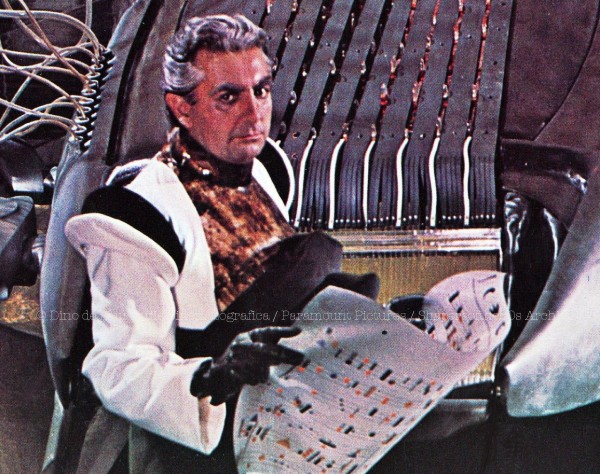
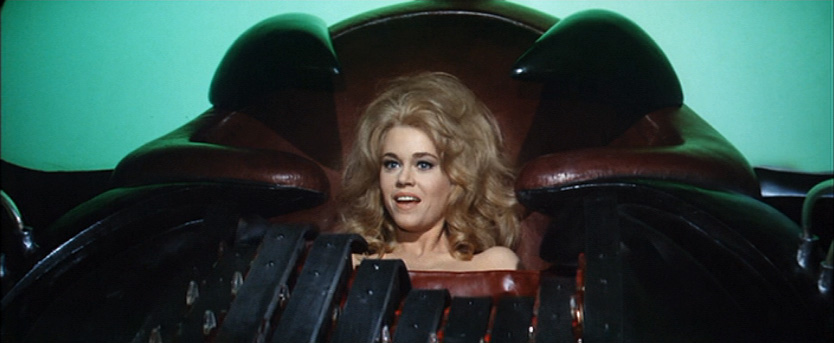
There is an evil, very sexy, Black Queen portrayed by Anita Pallenberg;

Through all this evil is the tortured "Angel Pygar" portrayed by John Phillip Law. Who sees the good in people and events.


In the end the "Matmos" explodes and "Pygar" saves both "Barbarella" and the "Black Queen". After all the torture she put him through. "Barbarella" asks why he saved the Queen and "Pygar" replies because:
Today, you're either going to like this film, or not. It is as the theme song implied. A product of the "Psychedelic" age as was 1967's "Casino Royale" in many scenes.
"Barbarella" was followed by five other motion pictures including 1968's "The Sergeant" with Rod Steiger and the 1970 sequel to the epic motion picture, based upon James A. Michener's novel, "Hawaii" called "The Hawaiians". The lead was portrayed by Charlton Heston and John Phillip Law was fifth billed. This film was based upon the next section of the novel.
July 28, 1971 saw John Phillip Law as Baron Manfred von Richthofen in Roger Corman's "Von Richthofen and Brown". A fictional World War One story about "The Red Baron". Which was an alternate title to the picture.
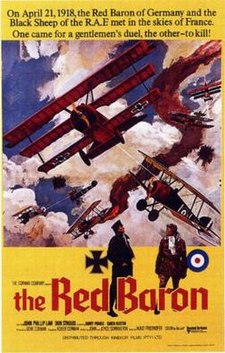

The picture has some great aerial scenes,

but unfortunately too much time is spent on the ground. Law is very good in his role as is Don Stroud as Canadian "Roy Brown". Stroud's an actor whose solid performances are well received and known. Examples of his films include 1968's "Coogan's Bluff" starring Clint Eastwood, 1970's "Bloody Mama", Roger Corman's story about Ma Barker starring Shelley Winters, 1978's "The Buddy Holly Story", the 1989 "James Bond" picture "License to Kill" and 2012's "Django Unchained".
Below Law and Stroud,


Screenplay writers John William Corrington and his wife Joyce Hopper Corrington created entirely fictional biographies for the two antagonists. The couple's previous credits had been the Soap Operas "Search for Tomorrow", "One Life to Live" and "Superior Court". After this picture the two wrote the screenplay for 1972's "Boxcar Bertha", Produced by Corman and his wife Julie, and Directed by an unknown Martin Scorsese. Along with 1973's "Battle for the Planet of the Apes".
Their screenplay has the two opponents as rivals with a somewhat parallel story line. Manfred Von Richtofen is shown as a high born aristocrat of the old school. Roy Brown has been a problem for his fellow British flyers for months. He doesn't understanding the "Rules of Respect and Engagement" between World War One flyers at the time of these events. "Roy" also wants to kill the German's and his dialogue has another parallel. That of American's towards the North Vietnamese near the end of our involvement in that war.
However, opposite of what is shown. Manfred von Richthofen's title did not make him above the lowest born German flyer in real life. While Roy Brown had only been with the British squadron for a few short weeks when he killed "The Red Baron".
The screenplay also adds other real people such as Manfred's brother Lothar and Herman Goring. Both flyers at the time, but like the two title opponents. The names are there, but not the truth.
This flawed motion picture is still worth a look.
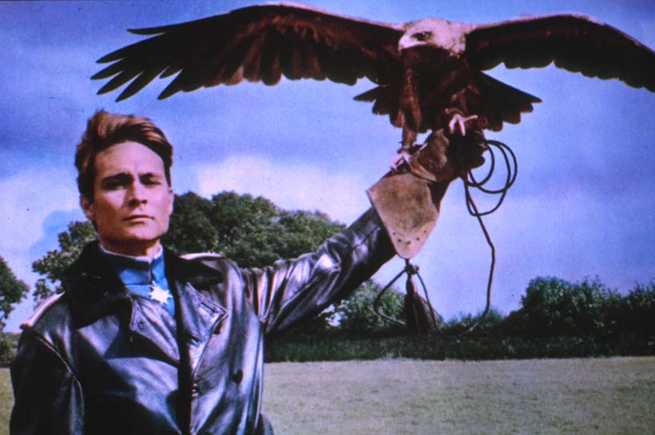

In 1966 novelist Jacqueline Susann wrote her novel "The Valley of the Dolls". The book is one of the highest selling novels in history and was made into a 1967 blockbuster movie of the same title. Like Harold Robbins best selling 1961 novel "The Carpetbaggers". Where the main characters were obviously Howard Hughes, Jean Harlow and William"Hopalong Cassidy" Boyd, called "Nevada Smith" and turned into a 1964 movie starring George Peppard, Carroll Baker and Alan Ladd. Jacqueline Susann's novel was obviously about Judy Garland, Carole Landis and Ethel Merman and turned into a 1967 movie starring Patty Duke, Barbara Perkins and Susan Hayward.
In 1969 Susann wrote "The Love Machine" about a television newscaster and anchor "Robin Stone". The fictional story was supposed to have been based upon James Aubrey. The one time President of the CBS Television network. In 1971 the motion picture version was released starring John Phillip Law as "Robin Stone".
Law would follow the successful "The Love Machine" with 1971's "The Last Movie". Written and Directed by Dennis Hopper. Then no other offers and the actor spent two years on the soap opera "The Young and the Restless" and finally made another motion picture in Italy.
THE GOLDEN VOYAGE OF SINBAD
+2+by+Brian+Bysouth.jpg)
On Decmeber 20, 1973 "The Golden Voyage of Sinbad" premiered in the U.K. This was the second Sinbad motion picture by the team of Producer Charles H. Schneer and Ray Harryhausen. The first had been 1958's "The 7th Voyage of Sinbad" and the third of this trilogy would be 1977's "Sinbad and the Eye of the Tiger".
My readers and I can debate which of the three is the best and which Sinbad is also. My personal favorite is John Phillip Law in this production. As to the character of "Sinbad the Sailor". He has even been portrayed by "Popeye's" arch enemy "Bluto" and renamed for Toshiro Mifune's character in an English dub of a Toho Japanese production. My article on "Sinbad" in motion pictures may be read at:
http://www.bewaretheblog.com/2018/05/sinbad-sindbad-sailor-from-popeye-to.html

Charles H. Schneer and Ray Harryhausen chose Gordon Hessler to Direct. Prior to this production Hessler had Directed Vincent Price in 1969's "The Oblong Box" and in 1970's "Scream and Scream Again" and "Cry of the Banshee". In 1971 Gordon Hessler Directed Jason Robards and Herbert Lom in "Murders in the Rue Morgue"
The screenplay was by Brian Clemens, born in Surrey, England, and a distant relative of Samuel "Mark Twain: Clemens. His previous works included 32 episodes of the BBC television series "The Avengers". Starting with the second episode of Season One. Then the very interesting 1971 screenplay, for Hammer, "Dr Jekyll and Sister Hyde". After this picture another very interesting Hammer variation on Vampires was his screenplay for the overlooked 1974 "Captain Kronos: Vampire Hunter". In 1993 Clemens wrote the "Highlander 2: the Quickening".
As Law's love interest and the mysterious young women of "Sinbad's" dreams, "Margiana", was Caroline Munro (seen in the above photo). In both 1971's "The Abominable Dr. Phibes" and 1972's "Dr. Phibes Rises Again". Without on screen credit Munro was Vincent Price's wife "Victoria Regina Phibes". She had appeared with Christoper Lee and Peter Cushing in 1972's "Dracula A.D. 1972" and would follow "Sinbad" with two other favorites on mine. 1974's previously mentioned "Captain Kronos: Vampire Hunter" and 1976's "At the Earth's Core" with Peter Cushing and Doug McClure.
The villain of the piece was Tom Baker. Although two years prior to this motion picture Baker had stolen his scenes as Grigori Yefimovich Rasputin in the epic based upon Robert K. Massie's "Nicholas and Alexandra". It was his role in this picture, as "Prince Koura", that finally convinced the producers of the BBC's "Dr. Who" to cast Tom Baker as the "Fourth Doctor".
The planets all stand still
Barbarella psychadela
There's a kind of cockle-shell about you
(Barbarella Ba-ba-barbarella)
Dazzle me with rainbow colors
Fade away the duller shade of living

The screnplay tells of "Barbarella'" receiving a direct order from the President of Earth to find and rescue the missing Earth scientist "Durand Durand", Milo O'Shea. Yes, this character was the source of the band's name. His last known whereabouts was the Tau Ceti planetary system. "Barbarella" crash lands on the 16th planet of that system and her adventures begin.
The planet is pure evil and makes Sodom and Gomorrah look like "Sesame Street", because of a liquefied substance called the "Matmos". In the future physical sex has been stopped and people use pills instead. There will be many sex jokes. As when "Barbarella" meets "Mark Hand the Catchman", Ugo Tognazzi,. He wants to do it the old fashion way and finally "Barbarella" finds she enjoys it, but David Hemmings portrays "Dildano" and he wants to do it the new way with the pill. Then there is the now evil "Durand Durand" who has invented a machine called the "Excessive Pleasure Machine" and places our heroine in it.


There is an evil, very sexy, Black Queen portrayed by Anita Pallenberg;

Through all this evil is the tortured "Angel Pygar" portrayed by John Phillip Law. Who sees the good in people and events.


In the end the "Matmos" explodes and "Pygar" saves both "Barbarella" and the "Black Queen". After all the torture she put him through. "Barbarella" asks why he saved the Queen and "Pygar" replies because:
An Angel Has No Memory
Today, you're either going to like this film, or not. It is as the theme song implied. A product of the "Psychedelic" age as was 1967's "Casino Royale" in many scenes.
"Barbarella" was followed by five other motion pictures including 1968's "The Sergeant" with Rod Steiger and the 1970 sequel to the epic motion picture, based upon James A. Michener's novel, "Hawaii" called "The Hawaiians". The lead was portrayed by Charlton Heston and John Phillip Law was fifth billed. This film was based upon the next section of the novel.
July 28, 1971 saw John Phillip Law as Baron Manfred von Richthofen in Roger Corman's "Von Richthofen and Brown". A fictional World War One story about "The Red Baron". Which was an alternate title to the picture.


The picture has some great aerial scenes,

but unfortunately too much time is spent on the ground. Law is very good in his role as is Don Stroud as Canadian "Roy Brown". Stroud's an actor whose solid performances are well received and known. Examples of his films include 1968's "Coogan's Bluff" starring Clint Eastwood, 1970's "Bloody Mama", Roger Corman's story about Ma Barker starring Shelley Winters, 1978's "The Buddy Holly Story", the 1989 "James Bond" picture "License to Kill" and 2012's "Django Unchained".
Below Law and Stroud,


Screenplay writers John William Corrington and his wife Joyce Hopper Corrington created entirely fictional biographies for the two antagonists. The couple's previous credits had been the Soap Operas "Search for Tomorrow", "One Life to Live" and "Superior Court". After this picture the two wrote the screenplay for 1972's "Boxcar Bertha", Produced by Corman and his wife Julie, and Directed by an unknown Martin Scorsese. Along with 1973's "Battle for the Planet of the Apes".
Their screenplay has the two opponents as rivals with a somewhat parallel story line. Manfred Von Richtofen is shown as a high born aristocrat of the old school. Roy Brown has been a problem for his fellow British flyers for months. He doesn't understanding the "Rules of Respect and Engagement" between World War One flyers at the time of these events. "Roy" also wants to kill the German's and his dialogue has another parallel. That of American's towards the North Vietnamese near the end of our involvement in that war.
However, opposite of what is shown. Manfred von Richthofen's title did not make him above the lowest born German flyer in real life. While Roy Brown had only been with the British squadron for a few short weeks when he killed "The Red Baron".
The screenplay also adds other real people such as Manfred's brother Lothar and Herman Goring. Both flyers at the time, but like the two title opponents. The names are there, but not the truth.
This flawed motion picture is still worth a look.

In 1966 novelist Jacqueline Susann wrote her novel "The Valley of the Dolls". The book is one of the highest selling novels in history and was made into a 1967 blockbuster movie of the same title. Like Harold Robbins best selling 1961 novel "The Carpetbaggers". Where the main characters were obviously Howard Hughes, Jean Harlow and William"Hopalong Cassidy" Boyd, called "Nevada Smith" and turned into a 1964 movie starring George Peppard, Carroll Baker and Alan Ladd. Jacqueline Susann's novel was obviously about Judy Garland, Carole Landis and Ethel Merman and turned into a 1967 movie starring Patty Duke, Barbara Perkins and Susan Hayward.
In 1969 Susann wrote "The Love Machine" about a television newscaster and anchor "Robin Stone". The fictional story was supposed to have been based upon James Aubrey. The one time President of the CBS Television network. In 1971 the motion picture version was released starring John Phillip Law as "Robin Stone".
Law would follow the successful "The Love Machine" with 1971's "The Last Movie". Written and Directed by Dennis Hopper. Then no other offers and the actor spent two years on the soap opera "The Young and the Restless" and finally made another motion picture in Italy.
THE GOLDEN VOYAGE OF SINBAD
+2+by+Brian+Bysouth.jpg)
On Decmeber 20, 1973 "The Golden Voyage of Sinbad" premiered in the U.K. This was the second Sinbad motion picture by the team of Producer Charles H. Schneer and Ray Harryhausen. The first had been 1958's "The 7th Voyage of Sinbad" and the third of this trilogy would be 1977's "Sinbad and the Eye of the Tiger".
My readers and I can debate which of the three is the best and which Sinbad is also. My personal favorite is John Phillip Law in this production. As to the character of "Sinbad the Sailor". He has even been portrayed by "Popeye's" arch enemy "Bluto" and renamed for Toshiro Mifune's character in an English dub of a Toho Japanese production. My article on "Sinbad" in motion pictures may be read at:
http://www.bewaretheblog.com/2018/05/sinbad-sindbad-sailor-from-popeye-to.html

Charles H. Schneer and Ray Harryhausen chose Gordon Hessler to Direct. Prior to this production Hessler had Directed Vincent Price in 1969's "The Oblong Box" and in 1970's "Scream and Scream Again" and "Cry of the Banshee". In 1971 Gordon Hessler Directed Jason Robards and Herbert Lom in "Murders in the Rue Morgue"
The screenplay was by Brian Clemens, born in Surrey, England, and a distant relative of Samuel "Mark Twain: Clemens. His previous works included 32 episodes of the BBC television series "The Avengers". Starting with the second episode of Season One. Then the very interesting 1971 screenplay, for Hammer, "Dr Jekyll and Sister Hyde". After this picture another very interesting Hammer variation on Vampires was his screenplay for the overlooked 1974 "Captain Kronos: Vampire Hunter". In 1993 Clemens wrote the "Highlander 2: the Quickening".
As Law's love interest and the mysterious young women of "Sinbad's" dreams, "Margiana", was Caroline Munro (seen in the above photo). In both 1971's "The Abominable Dr. Phibes" and 1972's "Dr. Phibes Rises Again". Without on screen credit Munro was Vincent Price's wife "Victoria Regina Phibes". She had appeared with Christoper Lee and Peter Cushing in 1972's "Dracula A.D. 1972" and would follow "Sinbad" with two other favorites on mine. 1974's previously mentioned "Captain Kronos: Vampire Hunter" and 1976's "At the Earth's Core" with Peter Cushing and Doug McClure.
The villain of the piece was Tom Baker. Although two years prior to this motion picture Baker had stolen his scenes as Grigori Yefimovich Rasputin in the epic based upon Robert K. Massie's "Nicholas and Alexandra". It was his role in this picture, as "Prince Koura", that finally convinced the producers of the BBC's "Dr. Who" to cast Tom Baker as the "Fourth Doctor".

The basic plot has a weird flying creature drop a Golden Tablet on "Sinbad's" ship. He decides to place it around his neck and that night he dreams of a young women with a tatoo of an eye on her hand.

Also in his dreams "Sinbad" sees a vision of "Prince Koura". Events lead him to the coast town of Marabia. There "Sinbad" meets the "Grand Vizier" who wears a golden mask to cover his scared face.

The "Vizier" explains that what ":Sinbad" has placed around his neck, Is one piece of a puzzle that leads to the "Fountain of Destiny" on the fabled continent of Lemuria. The "Vizier" shows "Sinbad" his own piece of the puzzle and the sailor realizes these are parts of a map.
The flying creature that dropped the piece of the map over "Sinbad's" ship was a homunculous made through dark magic using "Prince Koura's" own blood. This process is also draining "Koura" of his life force. The creature is sent to find out what the "Vizier" and "Sinbad'" plan and report back to "Koura". As he possesses the third piece of the puzzle to complete the map.

"Prince Koura" hires a ship to follow the sailor and his crew. As I said in my view John Phillip Law is the perfect "Sinbad" to counter Tom Baker's "Prince Koura" and interact with bravery against the creations of stop motion artist Ray Harryhausen.
In "The 7th Voyage of Sinbad" Harryhausen's improved stop motion process was called "Dynamation". In his next feature the "3 Worlds of Gulliver" the process became "Superdynamation" and starting with this feature the process was now called "Dynarama". Each version not just a name change, but a major improvement in the stop motion process over the previous one. The last using a vastly superior to British Black Screen as compared to either the typical Blue of the period, or the still be perfected Green Screen.
Among Ray Harryhausen's creations are the figurehead of "Sinbad's" ship that comes to life:
The Hindu goddess and destroyer of evil forces Kali:
A one eyed centaur:

A griffin that is the "Fountain of Destiny's" protector of good.

There is also a voice known as "The Oracle of All Knowledge", if you're good at voices. My reader would recognize it belonged too actor Robert Shaw. Best known for portraying "Donald 'Red' Grant" in the 1963 James Bond picture "From Russia With Love" and "Quint" in Steve Spielberg's 1975 "Jaws".
The final confrontation comes at the "Fountain of Destiny" and "Prince Koura" drops one piece of the tablet into it. Immediately his youth is restored and he summons the centaur. "Sinbad", "Margiana". the "Vizier" and the remaining members of the crew arrive at the fountain. The centaur attacks them, but the griffin appears to fight back.

"Prince Koura" uses the cloak of invisibility to fight "Sinbad". However, he makes the mistake of stepping into the water of the fountain and "Sinbad" sees and kills him. The "Fountain of Destiny" reveals the "Crown of Untold Riches" to the sailor. Instead of keeping it as his right. "Sinbad" places it on the "Vizier's" golden mask. This action changes the "Grand Vizier's" scarred face back to normal, his clothing to the royal robes of a Sultan.
Six motion pictures later, on December 18, 1976, found John Phillip Law at:
THE CASSANDRA CROSSING
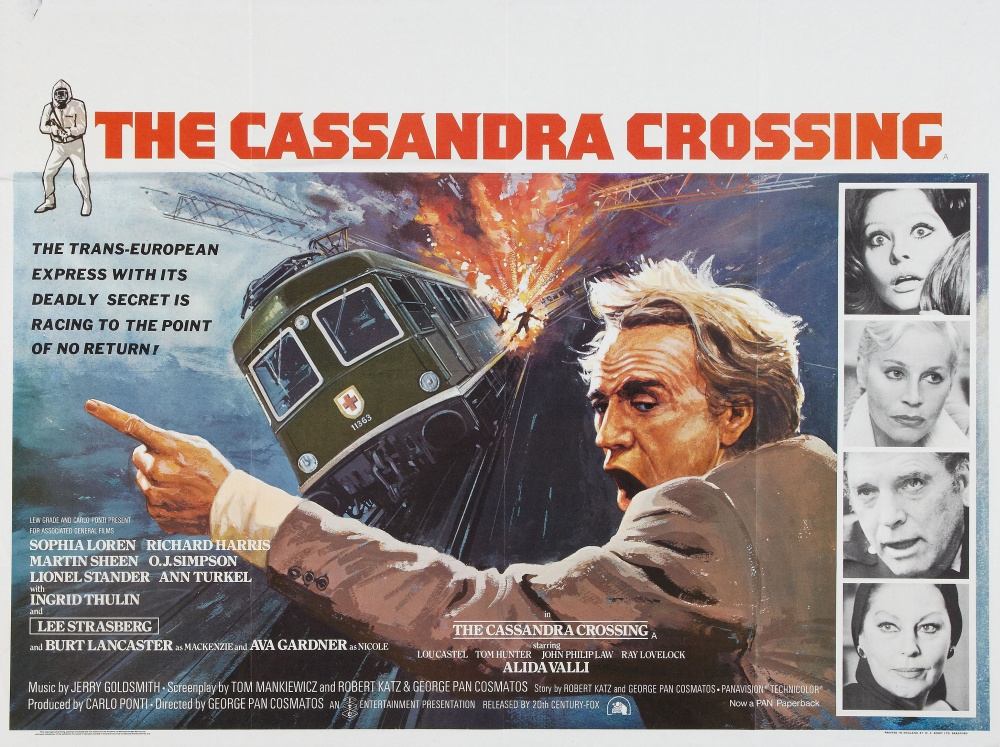
This is an excellent International all star motion picture about a train going from Geneva to Stockholm. After an robbery a terrorist with pneumonic plague hides on board infecting the passengers.
Burt Lancaster portrays, "Colonel Stephen MacKenzie", an American Military Intelligence Officer assigned to the International Health Organization. "MacKenzie" has to find a way to cover up that the United States was harboring germ warfare agents in a neutral country. His aide is "Major Stack" portrayed by John Phillip Law.

A griffin that is the "Fountain of Destiny's" protector of good.

There is also a voice known as "The Oracle of All Knowledge", if you're good at voices. My reader would recognize it belonged too actor Robert Shaw. Best known for portraying "Donald 'Red' Grant" in the 1963 James Bond picture "From Russia With Love" and "Quint" in Steve Spielberg's 1975 "Jaws".
The final confrontation comes at the "Fountain of Destiny" and "Prince Koura" drops one piece of the tablet into it. Immediately his youth is restored and he summons the centaur. "Sinbad", "Margiana". the "Vizier" and the remaining members of the crew arrive at the fountain. The centaur attacks them, but the griffin appears to fight back.

"Prince Koura" uses the cloak of invisibility to fight "Sinbad". However, he makes the mistake of stepping into the water of the fountain and "Sinbad" sees and kills him. The "Fountain of Destiny" reveals the "Crown of Untold Riches" to the sailor. Instead of keeping it as his right. "Sinbad" places it on the "Vizier's" golden mask. This action changes the "Grand Vizier's" scarred face back to normal, his clothing to the royal robes of a Sultan.
Six motion pictures later, on December 18, 1976, found John Phillip Law at:
THE CASSANDRA CROSSING

This is an excellent International all star motion picture about a train going from Geneva to Stockholm. After an robbery a terrorist with pneumonic plague hides on board infecting the passengers.
Burt Lancaster portrays, "Colonel Stephen MacKenzie", an American Military Intelligence Officer assigned to the International Health Organization. "MacKenzie" has to find a way to cover up that the United States was harboring germ warfare agents in a neutral country. His aide is "Major Stack" portrayed by John Phillip Law.
In the above photo is also Ingrid Thulin as IHO "Dr. Elena Stradner". "MacKenzie" and "Stradner" keep arguing over the strain of the plague and the possibility of saving the lives of the train's passengers. Of course through most of the story she has no idea why "McKenzie" doesn't seem to want to help the passengers.
On board the train is "Dr. Jonathan Chamberlain" portrayed by Richard Harris. He will be told what's happening. Also on board is his ex-wife "Jennifer Rispolli Chamberlain" portrayed by Sophia Loren.

Two other passengers include "Niccole Dressler" portrayed by Ava Gardner and her "Kept" young man "Robby Navarro" portrayed by Martin Sheen.

Below on the left is Lionel Standler as "Max" the train conductor and between Harris and Loren is O.J. Simpson as an FBI Agent named "Haley".

As the train travels further from Geneva the plague breaks out. The first stop on the line is reached with Soldiers in Hazmat suits holding weapons to shoot anyone that gets off.
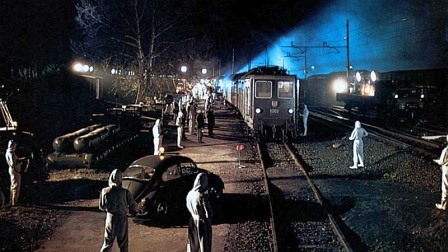
As the train proceeds again toward Stockholm "MacKenzie" makes the decision to send them to "The Cassandra Crossing". A bridge that hasn't been used, or repaired since 1948 leading into Poland. What will happen?
The screenplay is by Tom Mankiewicz the "James Bond" writer for 1971's "Diamonds Are Forever", 1973's "Live and Let Die" and 1974's "The Man With the Golden Gun". Also 1976's "The Eagle Has Landed". Keeps the pace moving.
As does Greco-Italian Director George P., Gosmatos.
.
ATTACK FORCE Z
When this Australian motion picture was originally released, May 18, 1981, John Phillip Law was top billed. However, the titles would be reworked and third billed Mel Gibson is now shown as the star and Law has the third billed position. Right behind originally fourth billed Sam Neil. After Gibson and Neil achieved International stardom and Law became all but forgotten outside of Italy.
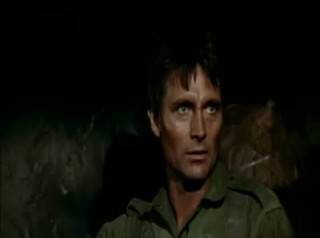
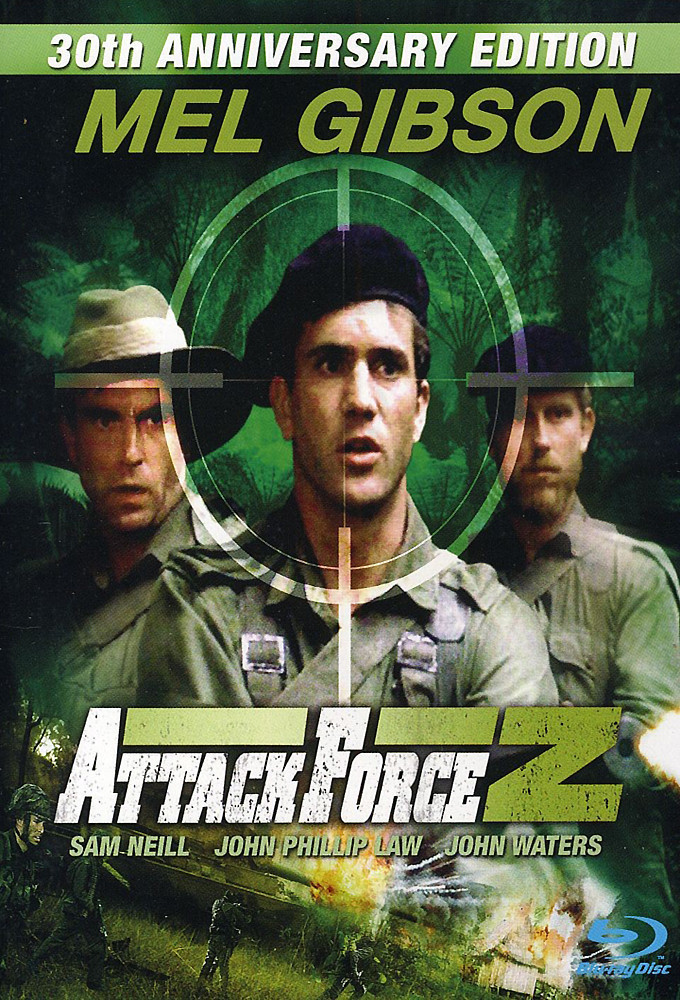
The picture was filmed in Thailand in 1979 and when released neither Mel GIbson, or Sam Neil were internationally known. Although Gibson's "Mad Max" was released with all the Australian accents, including Mel Gibson's, dubbed into, pardon the implication, English. So they could be understood outside of Australia and New Zealand. The dubbed version was shown in the United States first on March 21, 1980 a year after the original version was released in Australia. As for Irish actor Sam Neil. His first American movie was released March 20, 1981. In which he portrayed the devil's son "Damien Thorn" as an adult in "The Final Conflict".

The plot for "Attack Force Z" is a typical one based upon a true World War 2 event. Commandos are sent to an island to save a group of survivors from a plane crash. The island is a base for the Japanese army. None of the group led by "Captain P.G. 'Paul" Kelly", Mel Gibson, speak either Japanese, or the local native dialogue. However,"Lieutenant J.A. 'Jan' Veitch", John Phillip Law, does and is added to the squad. Sam Neil portrayed "Sergeant D.J. 'Danny' Costello.

Unknown to the squad is that "Captain Kelly" was given specific orders to rescue a Japanese defector named "Oshiko Imoguchi", Yu Wang, over all others. He is said to hold a secret that can end the war sooner. As I said the film is a much used plot not really used since the 1960's in Hollywood, or the U.K.
This picture was immediately followed on April 7, 1981, by one the earned six nominations for the "Golden Rapsberry Awards" and won one.
TARZAN THE APE MAN
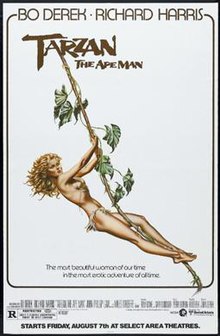
The picture was made by Actor/Director John Derek for his then wife Actress Bo Derek. Who also Produced this flop and insult to author Edgar Rice Burroughs. In it John Phillip Law portrayed African Guide and Hunter "Harry Holt", Richard Harris portrayed "James Parker", Bo Derek was his daughter "Jane Parker" and "Miles O'Keefe the title character of "Tarzan".

Above Richard Harris, Bo Derek and John Phillip Law.
As with the "Golden Raspberry's". The picture Won "Worst Actress" for Bo Derek and was nominated for "Worst Motion Picture", "Worst Screenplay", "Worst Director" John Derek, "Worst Actor" Richard Harris and "Worst New Star" Miles O'Keefe.
For those interested. Bo Derek won over Faye Dunaway's performance as Actress Joan Crawford in the winner for "Worst Motion Picture" "Mommie Dearest".
A combination of 15 movie and television appearances later. Found Law in a Science Fiction motion picture made in South Africa and released, first in the United States, in August 1988. This turkey has a certain cult status around the World and was honored with the full "Mystery Science Theater 3000" treatment.
SPACE MUTINY

To begin with ALL the spaceship special effects in "Space Mutiny" were LIFTED, being polite here to the South African's, from the original American television series of "Battlestar Galactica".
Actor Reb Brown portrayed the good guy "Dave Ryder". In 1979 Brown played "Captain America" in a bad made for television film. However, he made that up with the 1983 Science Fiction Cult Classic "Yor, the Hunter from the Future".

The villain of the piece, who sides with Space Pirates, is "Flight Commander Elijah Kalgan" portrayed by John Phillip Law.
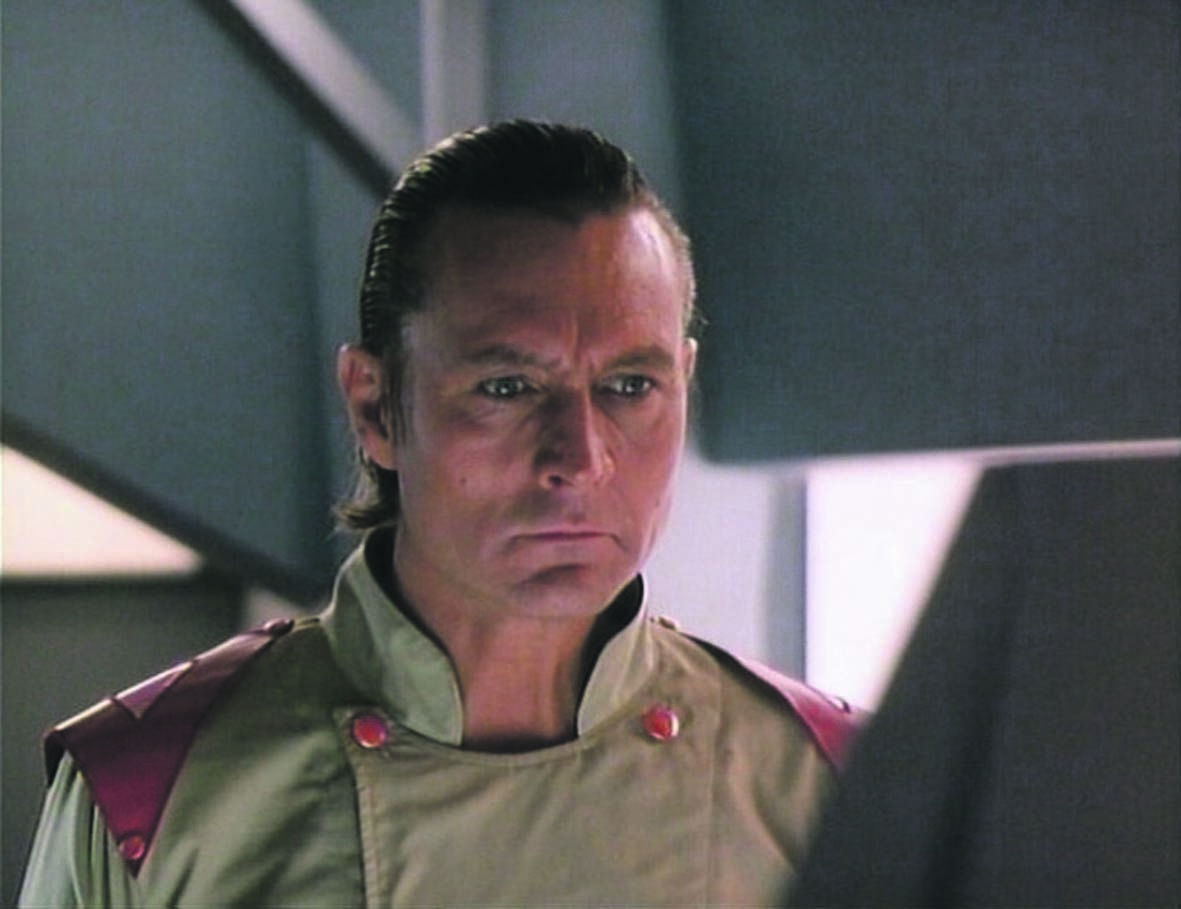
"Commander Alex Jansen" is portrayed by Cameron Mitchell.

"Dr. Lea Jameson" was portrayed by Cise Cameron aka: Mrs. Reb Brown.

There's more to ripping off "Galactica" then the shots in outer space. The space craft is a "Generation Ship" carrying a large number of immigrants to colonize another World. Sound vaguely familiar? You can also substitute "Commander Jansen" for "Commander Adama". The screenplay is credited to British Born South African Actor, Stuntman and former Soldier Ian Yule and Maria Dante. Who wrote this film and one other South African production.
The plot explains that the 'Southern Star" has people born on it. Who will grow old and eventually die without seeing any new World. While they search for the perfect World. Based upon information originally placed in the ships navigation computer.
This endless track upsets "Flight Commander Kalgan" and he believes others would also like it to end. His plan is to join forces with the Space Pirates, from the nearby "Corona Borealis" system, that have been attacking the ship. While with the help of "Chief Engineer MacPhearson", James Ryan, to tamper with the navigation computer to change the "Southern Star's" course. "Kalgan" will hijack the space craft. To further back up his plan will be to use the ship's Police Force, who have the friendly name of "The Enforcers". Thus the "Space Mutiny" begins.
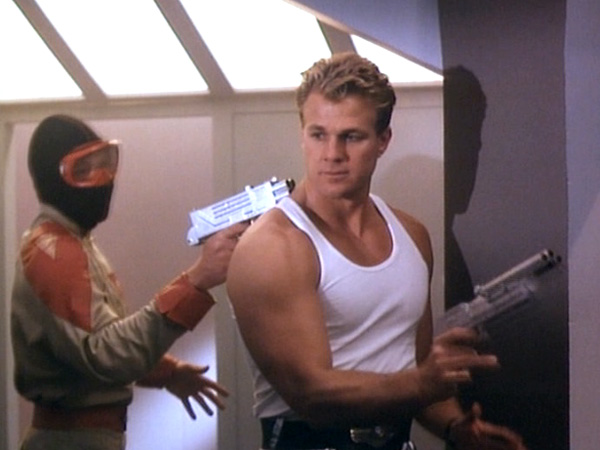

John Phillip Law returned to Italy to make an interesting horror film entitled in English:
BLOOD DELIRIUM
The original Italian "Delirio Di Sangue" translates directly into the English title. The picture was released sometime during 1988.
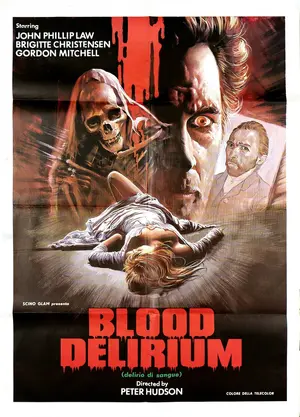
What is very noticeable and predictable is that Italian Director Sergio Bergonzelli's name, becomes "Peter Hudson" on both the Italian and English language versions. This was common practice going back to the 1950's in Italy. The idea was to give the impression a picture was made in the United States. Similarly it was used by many Italian and Spanish actors to have the audience think they were American.
This Italian horror film is mostly unknown outside of Europe, but it is very good. Think Roger Corman's early Poe films meet Mario Bava. However, a fair warning is the picture is not for everyone and some have described it as sick. That being said the story catches the viewers.
John Phillip Law is "Saint Simon" a painter living a happy life with his wife "Christine", She is portrayed by Danish actress Brigitte Christensen. Who appeared in 33 Italian productions between 1987 and 2018. "Christine" dies and "Saint Simon" becomes unbalanced but into his life comes a model named "Sybille". Who looks exactly, of course, like his dead wife and was played by Christensen.
As I said this sounds very familiar, but the screenplay, also by Sergio Bergonzelli, has a few interesting, if not morbid, twists to it. One of them is "Saint Simon's" butler "Herman". The character is played by Gordon Mitchell.
Mitchell came to Italy from the United States during the Steve Reeves body builder craze. He appeared in films such as 1961's "Atlas Against the Cyclops" and the title role in 1962's "Fury of Achilles". In the 1970's he switched to Spaghetti Westerns such as 1971's "Day of Judgement" and 1972's "A Gunman Called Dakota". Mitchell was also appearing in an occasional Italian horror picture. He was "Otto Frankenstein" in 1972's "Frankenstein '80" and "Igor" in 1974's "Frankenstein's Castle of Freaks".
After his wife dies, "Saint Simon", who considers himself the reincarnation of Vincent Van Gogh and "Herman" dig up "Christine's" corpse. They bring it to "Saint Simon's" studio as inspiration for his painting. "Saint Simon" also uses special high color paints in his work.
This is where things really get sick. When "Saint Simon" finds "Herman" attempting to rape "Christine;s" corpse. The problem for the painter is he now depends upon the butler for everything. Unknown to John Phillip Law's painter is that Gordon Mitchell's butler is murdering women and mixing their blood into "Saint Simon's" paints to get the right colors and textures.
Both actors are excellent in their respective roles, but Mitchell's "Herman" is just down right terrifying.
It was back to Australia for an Australian, Philippine, Vietnam War co-production released straight to video. Not in either country, but the U.K. on May 1, 1989. The film "A Case of Honor" starred John Philip Law as "Captain Roger L. Barnes" and American actor Timothy Bottoms as "Sergeant Joseph 'Hard' Case". Considered a lunatic by everyone. "Case" will still lead a group of POW's in an escape from a Vietnamese Prison.
Two more forgotten pictures and an Italian television series brought John Phillip Law to "The Alienator". Which critic Leonard Maltin thought was a "semi-remake" of the 1957 Robert Clarke Science Fiction "The Astounding She-Monster". The movies Director Fred Olsen Ray confirmed that belief.
It has never been confirmed if this feature just didn't go straight to Video, but there is some debate that it might have played somewhere in the United States around January 1989. Although it has a video release date of February 1990. Go figure.

Jan-Michael Vincent stars as the "Commander" of a alien space ship carrying a deadly prisoner named "Kol", Ross Hagen. John Phillip Law is seen as a Forest Ranger named "Ward Armstrong". Who must deal with both "Kol" and the "Alienator". Robert Clarke also appeared in the cameo role of "Lund" to give more credence that both films were related .Also in the cast were out of work actors Leo Gordon as "Colonel Colburn" and Robert "Count Yorga" Quary as "Doc Burnside". The rest of the cast you probably never heard of, or in some cases wouldn't be seen again.


The plot has "Kol", second picture above, escape and go to Earth to a small community in the woods. There is starts causing problems for a group of people and teenagers. The "Commander" sends down the gynoid aka: fembot called the "Alienator", Teagan Clive, to capture him and return "Kol" to the space craft.
The plot of "The Astounding She-Monster" has a group of gangsters kidnap a wealthy young women and take her to a cabin in the woods near a small community. An alien women appears and starts killing them. Robert Clarke owns the cabin and attempts to help the kidnapped women.

John Phillip Law's acting career was spiraling downward with a guest shot in an episode of a French Secret Service television series, television shows and films I could not locate even a description. However, on April 1993 the actor appeared as "Brigham Young" in a 72 minute video produced by "The Church of the Later Day Saints". It told a fictionalized story about the building of their Salt Lake City Temple.
On February 8th and 15th, 1997, audiences didn't see John Phillip Law, but heard his voice in a two part episode of the animated "Spiderman" entitled "Partners in Danger". The actor voiced the character of "John Hardesky" aka: "The Cat". The father of "The Black Cat".

This was followed by a movie made in Austria, another one entitled "CQ" released May 31, 2002 Written and Directed by Roman Coppala. In which he was ninth billed as "The Chairman". Then in October 2002 John Phillip Law was "Sheriff Murphy" having to put up with a dead miner brought back to life in "Curse of the Forty-Niner". "The picture had two other old pros in Karen Black, 1969's "Easy Rider", 1970's "Five Easy Pieces" and 1976's "Burnt Offerings", and my favorite villain Richard Lynch, 1982's "Sword and the Sorcerer" and Chuck Norris' enemy in 1985's "Invasion U.S.A.".

A 2005 appearance on an Austrian television crime/adventure series episode, a short subject and two other feature films followed. Then on May 13, 2008 John Phillip Law died in Los Angeles from pancreatic cancer.
In a 58 year motion picture acting career. John Phillip Law is remembered mainly for being the Angel "Pygar" in 1968's "Barbarella". Ray Harryhausen fans might bring up his name as the second "Sinbad" and fans of Lee Van Cleef that Law co-starred in "Death Rides A Horse". Otherwise outside of Italy he remains basically an unknown actor. RIP.
On board the train is "Dr. Jonathan Chamberlain" portrayed by Richard Harris. He will be told what's happening. Also on board is his ex-wife "Jennifer Rispolli Chamberlain" portrayed by Sophia Loren.

Two other passengers include "Niccole Dressler" portrayed by Ava Gardner and her "Kept" young man "Robby Navarro" portrayed by Martin Sheen.

Below on the left is Lionel Standler as "Max" the train conductor and between Harris and Loren is O.J. Simpson as an FBI Agent named "Haley".
As the train travels further from Geneva the plague breaks out. The first stop on the line is reached with Soldiers in Hazmat suits holding weapons to shoot anyone that gets off.

As the train proceeds again toward Stockholm "MacKenzie" makes the decision to send them to "The Cassandra Crossing". A bridge that hasn't been used, or repaired since 1948 leading into Poland. What will happen?
The screenplay is by Tom Mankiewicz the "James Bond" writer for 1971's "Diamonds Are Forever", 1973's "Live and Let Die" and 1974's "The Man With the Golden Gun". Also 1976's "The Eagle Has Landed". Keeps the pace moving.
As does Greco-Italian Director George P., Gosmatos.
.
ATTACK FORCE Z
When this Australian motion picture was originally released, May 18, 1981, John Phillip Law was top billed. However, the titles would be reworked and third billed Mel Gibson is now shown as the star and Law has the third billed position. Right behind originally fourth billed Sam Neil. After Gibson and Neil achieved International stardom and Law became all but forgotten outside of Italy.


The picture was filmed in Thailand in 1979 and when released neither Mel GIbson, or Sam Neil were internationally known. Although Gibson's "Mad Max" was released with all the Australian accents, including Mel Gibson's, dubbed into, pardon the implication, English. So they could be understood outside of Australia and New Zealand. The dubbed version was shown in the United States first on March 21, 1980 a year after the original version was released in Australia. As for Irish actor Sam Neil. His first American movie was released March 20, 1981. In which he portrayed the devil's son "Damien Thorn" as an adult in "The Final Conflict".

The plot for "Attack Force Z" is a typical one based upon a true World War 2 event. Commandos are sent to an island to save a group of survivors from a plane crash. The island is a base for the Japanese army. None of the group led by "Captain P.G. 'Paul" Kelly", Mel Gibson, speak either Japanese, or the local native dialogue. However,"Lieutenant J.A. 'Jan' Veitch", John Phillip Law, does and is added to the squad. Sam Neil portrayed "Sergeant D.J. 'Danny' Costello.

Unknown to the squad is that "Captain Kelly" was given specific orders to rescue a Japanese defector named "Oshiko Imoguchi", Yu Wang, over all others. He is said to hold a secret that can end the war sooner. As I said the film is a much used plot not really used since the 1960's in Hollywood, or the U.K.
This picture was immediately followed on April 7, 1981, by one the earned six nominations for the "Golden Rapsberry Awards" and won one.
TARZAN THE APE MAN

The picture was made by Actor/Director John Derek for his then wife Actress Bo Derek. Who also Produced this flop and insult to author Edgar Rice Burroughs. In it John Phillip Law portrayed African Guide and Hunter "Harry Holt", Richard Harris portrayed "James Parker", Bo Derek was his daughter "Jane Parker" and "Miles O'Keefe the title character of "Tarzan".

Above Richard Harris, Bo Derek and John Phillip Law.
As with the "Golden Raspberry's". The picture Won "Worst Actress" for Bo Derek and was nominated for "Worst Motion Picture", "Worst Screenplay", "Worst Director" John Derek, "Worst Actor" Richard Harris and "Worst New Star" Miles O'Keefe.
For those interested. Bo Derek won over Faye Dunaway's performance as Actress Joan Crawford in the winner for "Worst Motion Picture" "Mommie Dearest".
A combination of 15 movie and television appearances later. Found Law in a Science Fiction motion picture made in South Africa and released, first in the United States, in August 1988. This turkey has a certain cult status around the World and was honored with the full "Mystery Science Theater 3000" treatment.
SPACE MUTINY

To begin with ALL the spaceship special effects in "Space Mutiny" were LIFTED, being polite here to the South African's, from the original American television series of "Battlestar Galactica".
Actor Reb Brown portrayed the good guy "Dave Ryder". In 1979 Brown played "Captain America" in a bad made for television film. However, he made that up with the 1983 Science Fiction Cult Classic "Yor, the Hunter from the Future".

The villain of the piece, who sides with Space Pirates, is "Flight Commander Elijah Kalgan" portrayed by John Phillip Law.

"Commander Alex Jansen" is portrayed by Cameron Mitchell.

"Dr. Lea Jameson" was portrayed by Cise Cameron aka: Mrs. Reb Brown.

There's more to ripping off "Galactica" then the shots in outer space. The space craft is a "Generation Ship" carrying a large number of immigrants to colonize another World. Sound vaguely familiar? You can also substitute "Commander Jansen" for "Commander Adama". The screenplay is credited to British Born South African Actor, Stuntman and former Soldier Ian Yule and Maria Dante. Who wrote this film and one other South African production.
The plot explains that the 'Southern Star" has people born on it. Who will grow old and eventually die without seeing any new World. While they search for the perfect World. Based upon information originally placed in the ships navigation computer.
This endless track upsets "Flight Commander Kalgan" and he believes others would also like it to end. His plan is to join forces with the Space Pirates, from the nearby "Corona Borealis" system, that have been attacking the ship. While with the help of "Chief Engineer MacPhearson", James Ryan, to tamper with the navigation computer to change the "Southern Star's" course. "Kalgan" will hijack the space craft. To further back up his plan will be to use the ship's Police Force, who have the friendly name of "The Enforcers". Thus the "Space Mutiny" begins.


John Phillip Law returned to Italy to make an interesting horror film entitled in English:
BLOOD DELIRIUM
The original Italian "Delirio Di Sangue" translates directly into the English title. The picture was released sometime during 1988.

What is very noticeable and predictable is that Italian Director Sergio Bergonzelli's name, becomes "Peter Hudson" on both the Italian and English language versions. This was common practice going back to the 1950's in Italy. The idea was to give the impression a picture was made in the United States. Similarly it was used by many Italian and Spanish actors to have the audience think they were American.
This Italian horror film is mostly unknown outside of Europe, but it is very good. Think Roger Corman's early Poe films meet Mario Bava. However, a fair warning is the picture is not for everyone and some have described it as sick. That being said the story catches the viewers.
John Phillip Law is "Saint Simon" a painter living a happy life with his wife "Christine", She is portrayed by Danish actress Brigitte Christensen. Who appeared in 33 Italian productions between 1987 and 2018. "Christine" dies and "Saint Simon" becomes unbalanced but into his life comes a model named "Sybille". Who looks exactly, of course, like his dead wife and was played by Christensen.
As I said this sounds very familiar, but the screenplay, also by Sergio Bergonzelli, has a few interesting, if not morbid, twists to it. One of them is "Saint Simon's" butler "Herman". The character is played by Gordon Mitchell.
Mitchell came to Italy from the United States during the Steve Reeves body builder craze. He appeared in films such as 1961's "Atlas Against the Cyclops" and the title role in 1962's "Fury of Achilles". In the 1970's he switched to Spaghetti Westerns such as 1971's "Day of Judgement" and 1972's "A Gunman Called Dakota". Mitchell was also appearing in an occasional Italian horror picture. He was "Otto Frankenstein" in 1972's "Frankenstein '80" and "Igor" in 1974's "Frankenstein's Castle of Freaks".
After his wife dies, "Saint Simon", who considers himself the reincarnation of Vincent Van Gogh and "Herman" dig up "Christine's" corpse. They bring it to "Saint Simon's" studio as inspiration for his painting. "Saint Simon" also uses special high color paints in his work.
This is where things really get sick. When "Saint Simon" finds "Herman" attempting to rape "Christine;s" corpse. The problem for the painter is he now depends upon the butler for everything. Unknown to John Phillip Law's painter is that Gordon Mitchell's butler is murdering women and mixing their blood into "Saint Simon's" paints to get the right colors and textures.
Both actors are excellent in their respective roles, but Mitchell's "Herman" is just down right terrifying.
It was back to Australia for an Australian, Philippine, Vietnam War co-production released straight to video. Not in either country, but the U.K. on May 1, 1989. The film "A Case of Honor" starred John Philip Law as "Captain Roger L. Barnes" and American actor Timothy Bottoms as "Sergeant Joseph 'Hard' Case". Considered a lunatic by everyone. "Case" will still lead a group of POW's in an escape from a Vietnamese Prison.
Two more forgotten pictures and an Italian television series brought John Phillip Law to "The Alienator". Which critic Leonard Maltin thought was a "semi-remake" of the 1957 Robert Clarke Science Fiction "The Astounding She-Monster". The movies Director Fred Olsen Ray confirmed that belief.
It has never been confirmed if this feature just didn't go straight to Video, but there is some debate that it might have played somewhere in the United States around January 1989. Although it has a video release date of February 1990. Go figure.

Jan-Michael Vincent stars as the "Commander" of a alien space ship carrying a deadly prisoner named "Kol", Ross Hagen. John Phillip Law is seen as a Forest Ranger named "Ward Armstrong". Who must deal with both "Kol" and the "Alienator". Robert Clarke also appeared in the cameo role of "Lund" to give more credence that both films were related .Also in the cast were out of work actors Leo Gordon as "Colonel Colburn" and Robert "Count Yorga" Quary as "Doc Burnside". The rest of the cast you probably never heard of, or in some cases wouldn't be seen again.


The plot has "Kol", second picture above, escape and go to Earth to a small community in the woods. There is starts causing problems for a group of people and teenagers. The "Commander" sends down the gynoid aka: fembot called the "Alienator", Teagan Clive, to capture him and return "Kol" to the space craft.
The plot of "The Astounding She-Monster" has a group of gangsters kidnap a wealthy young women and take her to a cabin in the woods near a small community. An alien women appears and starts killing them. Robert Clarke owns the cabin and attempts to help the kidnapped women.

John Phillip Law's acting career was spiraling downward with a guest shot in an episode of a French Secret Service television series, television shows and films I could not locate even a description. However, on April 1993 the actor appeared as "Brigham Young" in a 72 minute video produced by "The Church of the Later Day Saints". It told a fictionalized story about the building of their Salt Lake City Temple.
On February 8th and 15th, 1997, audiences didn't see John Phillip Law, but heard his voice in a two part episode of the animated "Spiderman" entitled "Partners in Danger". The actor voiced the character of "John Hardesky" aka: "The Cat". The father of "The Black Cat".

This was followed by a movie made in Austria, another one entitled "CQ" released May 31, 2002 Written and Directed by Roman Coppala. In which he was ninth billed as "The Chairman". Then in October 2002 John Phillip Law was "Sheriff Murphy" having to put up with a dead miner brought back to life in "Curse of the Forty-Niner". "The picture had two other old pros in Karen Black, 1969's "Easy Rider", 1970's "Five Easy Pieces" and 1976's "Burnt Offerings", and my favorite villain Richard Lynch, 1982's "Sword and the Sorcerer" and Chuck Norris' enemy in 1985's "Invasion U.S.A.".

A 2005 appearance on an Austrian television crime/adventure series episode, a short subject and two other feature films followed. Then on May 13, 2008 John Phillip Law died in Los Angeles from pancreatic cancer.
In a 58 year motion picture acting career. John Phillip Law is remembered mainly for being the Angel "Pygar" in 1968's "Barbarella". Ray Harryhausen fans might bring up his name as the second "Sinbad" and fans of Lee Van Cleef that Law co-starred in "Death Rides A Horse". Otherwise outside of Italy he remains basically an unknown actor. RIP.







No comments:
Post a Comment